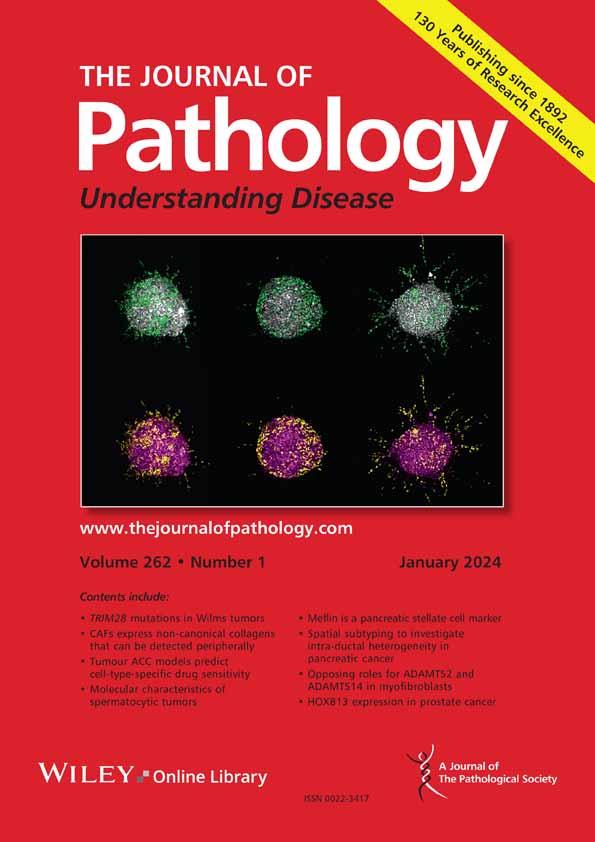Xue Kong, Jun Shi, Dongdong Sun, Lanqing Cheng, Can Wu, Zhiguo Jiang, Yushan Zheng, Wei Wang, Haibo Wu
求助PDF
{"title":"A deep-learning model for predicting tyrosine kinase inhibitor response from histology in gastrointestinal stromal tumor","authors":"Xue Kong, Jun Shi, Dongdong Sun, Lanqing Cheng, Can Wu, Zhiguo Jiang, Yushan Zheng, Wei Wang, Haibo Wu","doi":"10.1002/path.6399","DOIUrl":null,"url":null,"abstract":"<p>Over 90% of gastrointestinal stromal tumors (GISTs) harbor mutations in <i>KIT</i> or <i>PDGFRA</i> that can predict response to tyrosine kinase inhibitor (TKI) therapies, as recommended by NCCN (National Comprehensive Cancer Network) guidelines. However, gene sequencing for mutation testing is expensive and time-consuming and is susceptible to a variety of preanalytical factors. To overcome the challenges associated with genetic screening by sequencing, in the current study we developed an artificial intelligence-based deep-learning (DL) model that uses convolutional neural networks (CNN) to analyze digitized hematoxylin and eosin staining in tumor histological sections to predict potential response to imatinib or avapritinib treatment in GIST patients. Assessment with an independent testing set showed that our DL model could predict imatinib sensitivity with an area under the curve (AUC) of 0.902 in case-wise analysis and 0.807 in slide-wise analysis. Case-level AUCs for predicting imatinib-dose-adjustment cases, avapritinib-sensitive cases, and wildtype GISTs were 0.920, 0.958, and 0.776, respectively, while slide-level AUCs for these respective groups were 0.714, 0.922, and 0.886, respectively. Our model showed comparable or better prediction of actual response to TKI than sequencing-based screening (accuracy 0.9286 versus 0.8929; DL model versus sequencing), while predictions of nonresponse to imatinib/avapritinib showed markedly higher accuracy than sequencing (0.7143 versus 0.4286). These results demonstrate the potential of a DL model to improve predictions of treatment response to TKI therapy from histology in GIST patients. © 2025 The Pathological Society of Great Britain and Ireland.</p>","PeriodicalId":232,"journal":{"name":"The Journal of Pathology","volume":"265 4","pages":"462-471"},"PeriodicalIF":5.2000,"publicationDate":"2025-02-14","publicationTypes":"Journal Article","fieldsOfStudy":null,"isOpenAccess":false,"openAccessPdf":"","citationCount":"0","resultStr":null,"platform":"Semanticscholar","paperid":null,"PeriodicalName":"The Journal of Pathology","FirstCategoryId":"3","ListUrlMain":"https://pathsocjournals.onlinelibrary.wiley.com/doi/10.1002/path.6399","RegionNum":2,"RegionCategory":"医学","ArticlePicture":[],"TitleCN":null,"AbstractTextCN":null,"PMCID":null,"EPubDate":"","PubModel":"","JCR":"Q1","JCRName":"ONCOLOGY","Score":null,"Total":0}
引用次数: 0
引用
批量引用
Abstract
Over 90% of gastrointestinal stromal tumors (GISTs) harbor mutations in KIT or PDGFRA that can predict response to tyrosine kinase inhibitor (TKI) therapies, as recommended by NCCN (National Comprehensive Cancer Network) guidelines. However, gene sequencing for mutation testing is expensive and time-consuming and is susceptible to a variety of preanalytical factors. To overcome the challenges associated with genetic screening by sequencing, in the current study we developed an artificial intelligence-based deep-learning (DL) model that uses convolutional neural networks (CNN) to analyze digitized hematoxylin and eosin staining in tumor histological sections to predict potential response to imatinib or avapritinib treatment in GIST patients. Assessment with an independent testing set showed that our DL model could predict imatinib sensitivity with an area under the curve (AUC) of 0.902 in case-wise analysis and 0.807 in slide-wise analysis. Case-level AUCs for predicting imatinib-dose-adjustment cases, avapritinib-sensitive cases, and wildtype GISTs were 0.920, 0.958, and 0.776, respectively, while slide-level AUCs for these respective groups were 0.714, 0.922, and 0.886, respectively. Our model showed comparable or better prediction of actual response to TKI than sequencing-based screening (accuracy 0.9286 versus 0.8929; DL model versus sequencing), while predictions of nonresponse to imatinib/avapritinib showed markedly higher accuracy than sequencing (0.7143 versus 0.4286). These results demonstrate the potential of a DL model to improve predictions of treatment response to TKI therapy from histology in GIST patients. © 2025 The Pathological Society of Great Britain and Ireland.
基于组织学预测胃肠道间质瘤中酪氨酸激酶抑制剂反应的深度学习模型。
根据美国国家综合癌症网络(NCCN)指南的建议,90%以上的胃肠道间质瘤(GIST)都存在KIT或PDGFRA突变,可以预测对酪氨酸激酶抑制剂(TKI)疗法的反应。然而,用于突变检测的基因测序既昂贵又耗时,而且容易受到各种分析前因素的影响。为了克服基因测序筛查所面临的挑战,我们在本研究中开发了一种基于人工智能的深度学习(DL)该模型使用卷积神经网络(CNN)分析肿瘤组织学切片中数字化苏木精和伊红染色,以预测GIST患者对伊马替尼或阿伐替尼治疗的潜在反应。独立测试集的评估结果表明,我们的 DL 模型可以预测伊马替尼的敏感性,病例分析的曲线下面积(AUC)为 0.902,滑动分析的曲线下面积(AUC)为 0.807。预测伊马替尼剂量调整病例、阿伐替尼敏感病例和野生型GIST的病例水平AUC分别为0.920、0.958和0.776,而这些组别的滑动水平AUC分别为0.714、0.922和0.886。与基于测序的筛查相比,我们的模型对 TKI 实际应答的预测效果相当或更好(准确率为 0.9286 对 0.8929;DL 模型对测序),而对伊马替尼/阿伐替尼无应答的预测准确率明显高于测序(0.7143 对 0.4286)。这些结果表明,DL 模型有可能改善根据组织学预测 GIST 患者对 TKI 治疗的反应。© 2025 大不列颠及爱尔兰病理学会。
本文章由计算机程序翻译,如有差异,请以英文原文为准。






 求助内容:
求助内容: 应助结果提醒方式:
应助结果提醒方式:


